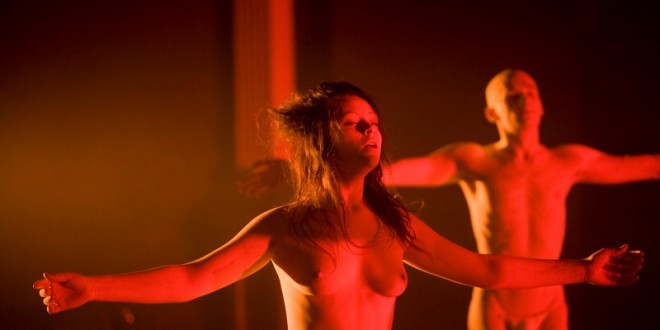November 2009
I have been spending considerable time contemplating my connection with Zen Zen Zo, a theatre company known for their uninhibited and sometimes confronting physical style. I have created music for twelve productions over a period of fifteen years
Finally this morning I think I found at least one of those connections. When the company responds to the music I have created, they do so in a way that I would love to, but cannot. Their involvement is so total, their bodies stretched and thrown. I can see intense feelings in the faces, the muscles the explosions of energy that are present even in stillness. Their almost-nakedness gives a reality, a humanity that costume obscures and confuses. To watch the performance, the rehearsal, the movement-making is greatly consuming for me.
I can feel the force, but not express it, not move to it, not allow myself to own it. What is really stupid about this is that it's my own music! Its not just stupid, it's quite frightening and upsetting. As I write this I find my throat tighten and my head constrict. I'm jealous of someone else's feelings, how ridiculous!
When I make the music, I revel in the moment, strike the keys, tweak the parameters, move with the melody, embody the sound. I have my own emotional journey that is entire and embodied and real and valid, yet fragmented and dispassionate, moving as it it does through playing, editing, mixing, fixing, re-mixing, tweaking, playing again, endlessly listening into the moments.
I am listening as I write this to The Spiritual Axis. It is a piece I wrote for the company some years ago for one of their training exercises and it continues to be one of their favourites. "The Spiritual Axis" title refers to a spiritual link between Australia and Japan via the Pacific Rim, that is described in the Writings of the Baha'i Faith (Effendi 1970), although the term is found in Chinese medicine, Buddhist and Hindu theology as a meeting point of the body and soul. At twenty four minutes, it is one of my longer pieces and is broken into two distinct phases based on the movement principles. The movement exercise "the spin" owes some heritage to the physical theatre work of Tadashi Suzuki and to the whirling Dervish. The dancers begin in a breathing, a deep, deep breathing that seems to pull from somewhere beneath the earth, beginning to a slow and graceful step. The music mixes gentle koto and bamboo flute, with simple rhythmic drum and mbira and deep organic tones generated by granular synthesis. The connection to earth is reinforced by the use of giant, barely struck gong tones that resonate at almost sub-sonic frequencies.
As the second section begins, the dancers begin to spin on the spot, their arms outstretched, watching their own fingertips, their feet step and pivot. There is a serenity in the faces as if in a meditation, they seem to be seeing something that I can not. Over eight minutes the tempo of the music doubles from 80 to 160 beats per minute and the speed of the spinning increases perhaps to 40 times a minute, each of the dancers finding their own momentum. In performance the dancers wear long skirts that fly and surround them. As the tempo builds, with drums, finger symbols, metalophones, the flutes from the first section return accompanied by smooth chordal strings, the melodies and fluid over the frenetic pace of the percussion. The tempo returns to its 80 BPM bas over a slightly shorter period, the melodic elements retained as the percussion simplifies and the more major harmonic context defined by mbira.
I asked some of the company members who have performed this exercise and used it with students, to describe the experience to me. I was frankly shocked and uncomfortable at the depth of emotion it brought to the surface, one of the teacher's voice breaking as she spoke. I asked her to email me a response.
I often teach the spin, in particular as culmination to weeklong interstate intensives. The exercise itself is very powerful and yet somehow I can't imagine it being what it is without your music. Time and time again, though I always feel the need to keep on my 'teacher's cap', I find that the music touches me in the most delicate of places. Of course, that happens in conjunction with watching the participants going through this intense experience, but to me the expression on their faces and your music are not only inseparable, but they seem to be linked in some inexplicable fashion.
Your music unravels me and brings me to tears every time. Despite my best intentions to remain cool, calm and collected...
Thank you (Rotem 2009, personal communication).
I wish I could have that too.
Related Posts
- Control Freak: My compositional style is based on controlling as many elements as possible. But how does this relate to instantaneous expression?
- Terror: The Terror is a piece that was originally written for Zen Zen Zo to express the horror of the 1995 Kobe earthquake.
- Video Complexities: People are much more complex than I thought possible.
- You don't know what you don't know ...: Giving a label of "different" to an experience that is "normal for me" results in a re-evaluatuion of a whole life.
- Current practice: I am now teaching music and sound production full time at Tertiary level and continue to work compose for collaborative projects.
- Macbeth by Fax: My first collaborative piece with Zen Zen Zo was created long distance, mostly through written communication by fax.
- Eye Contact: On some occasions an unexpected emotional connection occurs, and can be overwhelming.
